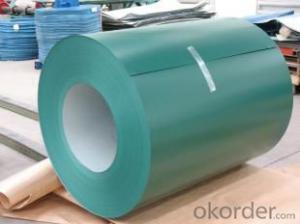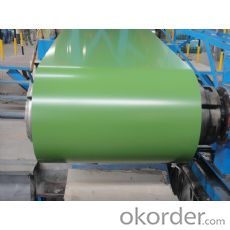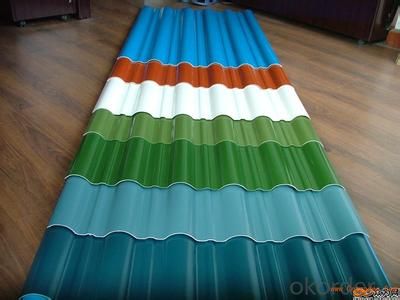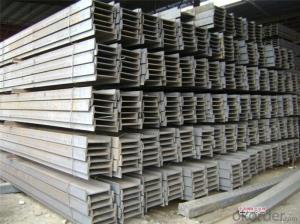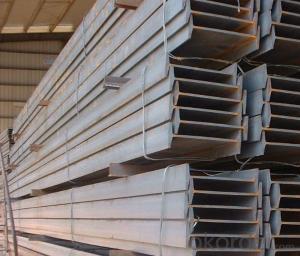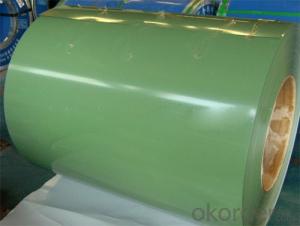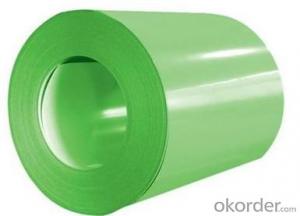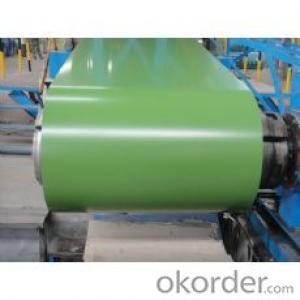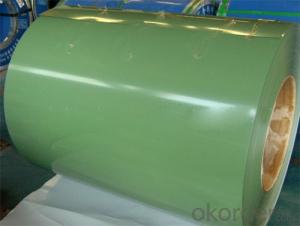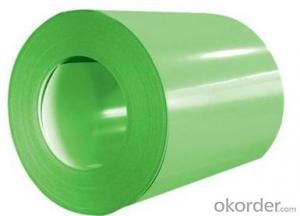Pre Painted Galvanized/Aluzinc Steel Coils of Best Quality Green Color
- Loading Port:
- Shanghai
- Payment Terms:
- TT OR LC
- Min Order Qty:
- 50 m.t.
- Supply Capability:
- 2000 m.t./month
OKorder Service Pledge
OKorder Financial Service
You Might Also Like
1. Pre-Painted Galvanized/Aluzinc Steel Coil Description:
With GI as base material, after pretreatment (degrease and chemical treatment ) and liquid dope with several layers of color, then after firing and cooling, finally the plate steel is called pre-painted galvanized (aluzinc) steel. Pre-painted galvanized steel is good capable of decoration, molding, corrosion resistance. It generally displays superior workability, durability and weather resistance.
2.Main Features of the Pre-Painted Galvanized/Aluzinc Steel Coil:
• Excellent process capability
• Smooth and flat surface
• Workability, durability
• Excellent heat resistance performance
• High strength
• Good formability
• Good visual effect
3.Pre-Painted Galvanized/Aluzinc Steel Coil Images

4.Pre-Painted Galvanized/Aluzinc Steel Coil Specification
Standard: AISI, ASTM, BS, DIN, GB, JIS
Grade: DX51D, DX52D
Thickness: 0.17-2.0mm
Brand Name: KMRLON
Model Number: coil
Type: Steel Coil
Technique: Cold Rolled
Surface Treatment: Coated
Application: Boiler Plate
Special Use: High-strength Steel Plate
Width: 20-1250mm
Length: customized
commoidty: pre-painted galvanized steel coil
Thickness: 0.13-4.0mm
width: 20-1250mm
zinc coating: 40-180g/m2
printing thickness: top side: 20+/-5 microns, back side: 5-7 microns
color: all RAL color
surface treatment: color coated
coil weight: 4-7 tons
coil ID: 508/610mm
packaging: standard seaworthy packing
5.FAQ of Pre-Painted Galvanized/Aluzinc Steel Coil
1. What’s the application of this product?
Roof, roof structure, surface sheet of balcony, frame of window, etc.
2. What’s the brand of the paint?
We use the best brand of all of the word—AKZO.
3. How about your company?
A world class manufacturer & supplier of castings forging in carbon steel and alloy steel,is one of the large-scale professional investment casting production bases in China,consisting of both casting foundry forging and machining factory. Annually more than 8000 tons Precision casting and forging parts are exported to markets in Europe,America and Japan. OEM casting and forging service available according to customer’s requirements.
4. How to guarantee the quality of the products?
We have established the international advanced quality management system,every link from raw material to final product we have strict quality test;We resolutely put an end to unqualified products flowing into the market. At the same time, we will provide necessary follow-up service assurance.
5. How long can we receive the product after purchase?
Usually within thirty working days after receiving buyer’s advance payment or LC. We will arrange the factory manufacturing as soon as possible. The cargo readiness usually takes 15-25 days, but the shipment will depend on the vessel situation.
- Q: How do steel I-beams perform in terms of deflection?
- Steel I-beams are known for their excellent performance in terms of deflection. Due to their shape and material properties, they have a high resistance to bending and deflection under load. The shape of the I-beam, with its flanges and web, allows for the distribution of load along the entire length of the beam, resulting in minimal deflection. Additionally, the use of steel as the material for I-beams provides high tensile strength, which further enhances their deflection performance. Overall, steel I-beams are one of the most effective structural elements for minimizing deflection and ensuring stability in various construction and engineering applications.
- Q: Can steel I-beams be used as columns or posts in construction?
- Yes, steel I-beams can be used as columns or posts in construction. They are commonly used in structural applications where strength and durability are required. I-beams provide excellent load-bearing capacity and are often preferred for their ability to support heavy loads and resist bending or buckling.
- Q: What is the supply length of 30# I-beam?
- The supply length of 30# I-beam is usually 12 meters. The length of the steel bar is generally 9m and 12m; the length of the I-beam and H section steel is generally 12m; the factory length of the angle steel is generally 6 meters; the common length of the channel steel is 6 meters, /8 meters and /9 meters.
- Q: Can steel I-beams be used for residential roof structures?
- Yes, steel I-beams can be used for residential roof structures. They provide structural strength and durability, making them suitable for supporting the weight of the roof and other loads. Additionally, steel I-beams allow for longer spans, which can create open and spacious interior designs.
- Q: How do steel I-beams perform in terms of seismic resistance?
- Steel I-beams are known for their exceptional seismic resistance. The structural design of I-beams allows them to withstand the forces generated during an earthquake. The shape of I-beams provides a high strength-to-weight ratio, making them capable of supporting heavy loads while remaining flexible enough to absorb and dissipate seismic energy. One of the key advantages of steel I-beams in terms of seismic resistance is their ductility. Ductility refers to a material's ability to deform under stress without fracturing. During an earthquake, the ground shakes, causing the building to vibrate. Steel I-beams can flex and bend without breaking, absorbing the seismic energy and preventing catastrophic failures. This ability to deform and absorb energy helps to distribute the forces generated by an earthquake throughout the structure, minimizing localized damage. Additionally, steel I-beams can be easily reinforced and retrofitted to enhance their seismic resistance. By adding additional bracing, cross-members, or steel plates, the overall stiffness and strength of the I-beams can be increased, improving their performance during an earthquake. Furthermore, steel is a homogeneous material with consistent properties, which allows for accurate engineering calculations and predictable behavior under seismic loads. This predictability enables engineers to design structures that meet the necessary safety standards for seismic resistance. Overall, steel I-beams are widely recognized for their excellent seismic resistance. Their strong and flexible nature, combined with the ability to reinforce and retrofit them, make them a preferred choice for earthquake-prone areas, ensuring the safety and stability of buildings during seismic events.
- Q: How do you calculate the shear force in a steel I-beam?
- To calculate the shear force in a steel I-beam, you need to consider the applied loads and the structural properties of the beam. The shear force represents the internal force that acts parallel to the longitudinal axis of the beam, causing it to deform or fail. To calculate the shear force, you must first determine the external loads acting on the beam, such as point loads, distributed loads, or moments. These loads can be determined from the design or analysis of the specific structure or from the application of the beam. Once the external loads are known, you can analyze the distribution of these loads over the length of the beam. This involves determining the position and magnitude of the loads at various points along the beam. For example, if you have a uniformly distributed load, you would need to determine the load per unit length. Next, you need to determine the support conditions of the beam, such as whether it is simply supported or fixed at both ends. This information is crucial in calculating the reactions at the supports, as they will influence the shear force. After determining the load distribution and the support conditions, you can proceed to calculate the shear force at any given point along the beam. To do this, you need to consider the equilibrium of forces at that specific point. At any section of the beam, the sum of the vertical forces must be equal to zero. By considering the external loads and the reactions at the supports, you can calculate the shear force at that specific section. This can be done using the method of sections or by calculating the change in shear force between two neighboring sections. Additionally, it is important to consider the structural properties of the steel I-beam, such as its moment of inertia and the distance from the neutral axis to the extreme fibers. These properties influence the distribution of shear force within the beam and must be taken into account during the calculations. Overall, calculating the shear force in a steel I-beam requires a thorough analysis of the external loads, support conditions, and structural properties. By applying the principles of equilibrium and considering the specific characteristics of the beam, you can accurately determine the shear force at any point along the beam.
- Q: What are the common methods of connecting steel I-beams to other structural elements?
- There are several common methods for connecting steel I-beams to other structural elements. Some of the most frequently used methods include welding, bolting, and using specialized connectors such as beam clamps or beam hangers. These methods ensure a strong and secure connection between the steel I-beams and other structural elements, allowing for a robust and reliable overall structure.
- Q: What is the flange thickness of I-beam?
- I-beam is also called steel girder (English name Universal Beam). It is a strip of steel with an I-shaped section. I-beam is divided into ordinary I-beam and light I-beam, H steel three. It is a section steel whose shape is trough.
- Q: Can steel I-beams be used in residential remodeling or addition projects?
- Residential remodeling or addition projects can indeed utilize steel I-beams. The reason behind this lies in the strength and durability of these beams, which are commonly employed as structural support. They can effectively replace load-bearing walls, create open-concept spaces, or provide support for additional floors or additions. Their remarkable ability to withstand heavy loads and span longer distances than traditional wood beams makes them the ideal choice. Moreover, their smaller profile compared to wood beams allows for greater design flexibility, thereby maximizing usable space in residential projects. Nevertheless, it is crucial to consult with a structural engineer or professional contractor to ensure that the steel I-beams are appropriately sized and installed, meeting the specific structural requirements of the project.
- Q: In steel engineering, what is called rigid connection? What is articulated? What kind of nodes or structural parts are applicable to the two? The more detailed the answer, the better!
- To connect by means of hinges. A device or part commonly used in two parts of a machine, vehicle, door, window, and implement, such as articulated trolley buses, articulated freight cars, articulated buses.
Send your message to us
Pre Painted Galvanized/Aluzinc Steel Coils of Best Quality Green Color
- Loading Port:
- Shanghai
- Payment Terms:
- TT OR LC
- Min Order Qty:
- 50 m.t.
- Supply Capability:
- 2000 m.t./month
OKorder Service Pledge
OKorder Financial Service
Similar products
Hot products
Hot Searches
Related keywords
